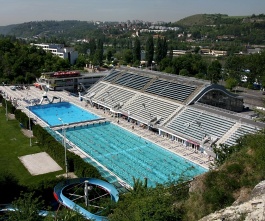
Podolský swimming pool, opened 50 years ago, was supposed to host the Olympics as well
 |
The Podolí swimming complex stands on the site of a former limestone quarry. The mining, which ended in 1945, created a nook that is sheltered from the wind on three sides and is exposed to sunlight for most of the day. In short, a place made for a swimming area.
Among various architectural designs, the project by academic architect Richard Podzemný was selected in the mid-1950s. To counter the winds blowing from the nearby Vltava River, Podzemný built an interestingly designed indoor pool made of glass and concrete, featuring a roof shaped like a wave. Besides its aesthetic value, it also serves a practical purpose—acting as a grandstand for 5,000 spectators.
Construction of the swimming complex on the site of a former cement plant began in the autumn of 1959, and the following year, swimming races were held in the incomplete complex. Participants faced what witnesses describe as Spartan conditions; the pools lacked filtration, and two locomobiles struggled to heat the water without much effect.
The operation of the completed complex was ceremonially launched at the end of June 1965. Visitors already had access to an indoor fifty-meter pool (only the third in the republic after Žilina and Olomouc) and two outdoor pools with diving towers. All of this, along with the necessary facilities, cost 48 million crowns.
 |
The area gradually expanded and continued to offer its visitors new attractions. In 1967, one of the smaller outdoor pools was kept open throughout the winter for the first time. What initially seemed like a curiosity quickly became a tradition: swimming in 26 degrees Celsius warm water amidst snowy Prague is a unique experience.
One technical point related to heating the water is noteworthy. Since the mid-1980s, the swimming complex has been connected by pipeline to the headquarters of Czech Television on Kavčí hory. There, the cold water from Podolí is used to cool the studios, then returned as warm water, thereby improving the energy balance of the pool.
The Podolí pool is not only a place for public aquatic fun but has also hosted numerous sporting events. The most significant competition held here was the 1997 European Masters Swimming and Diving Championships. It attracted 3,255 swimmers and 148 divers from 32 countries. The waters of Podolí seemed to favor the competitors, as three world records and 59 European records were broken.
Less known is the fact that the stadium could have hosted even more famous competitions in the past. In the late 1960s, the idea of nominating Prague as a host city for the 1980 Olympic Games was born in Czechoslovakia. Had this come to pass, the swimming competitions would most likely have been held in Podolí. However, the invasion of the armies of five Warsaw Pact countries in August 1968 put an end to discussions about the Prague Olympics.
Despite its half-century-long history, the Podolí pool is not the oldest facility of its kind in Prague. The first indoor pool in the capital was built in 1925. It was established as part of Tyrš's House, the seat of the Czech Sokol Organization, and it still serves both Sokols and the public today. Gradually, more indoor and outdoor pools were added. In November 1999, the first water park with a truly large waterslide, Letňany Lagoon, opened in Prague.
The most recent addition to the list of Prague's pools and aquatic centers is the Eleven Water World complex, which opened in June last year in Chodov. In December 2012, the Aquacenter Šutka in Prague 8 was also completed after more than twenty years.
The English translation is powered by AI tool. Switch to Czech to view the original text source.
0 comments
add comment












